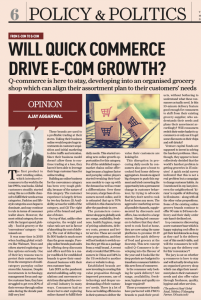Most retailers only manage 4 or 5 of these touch points, creating a huge opportunity for competitors to address the unmanaged points.
As modern retail gains ground in India, brands have begun competing with each other and retailers have begun putting aside budgets for brand building, CRM implementation, building consumer experience in the store and multi-channel retailing.
Multi-channel retailing is the new flavour for global retailers and they are making huge investments on technological tools. Indian retailers are now preparing themselves to follow suit.
I see this as a positive sign that the consumer is now emerging as an important entity in the business models of India retailers, and they are now willing to spend money to win the confidence of the consumers.
However, I personally have a different take on the overall approach retailers must use to win consumer loyalty, which, I believe, will be not just less expensive, but far more effective as well.
The first customer service initiative a forward-thinking retailer must have is to set up and implement a Consumer Service Management (CSM) policy. This policy must align the organisation with consumer-oriented thinking and strategies. A retailer’s CSM policy should be designed around the consumer buying process. This means that you can’t view your retail business in terms of how you sell, but in terms of how your consumer wants to buy from you.
Let us take a simple and basic example of a 13-step process for buying in a super market store which shows all the consumer touch points managed by the retailer as well the touch points not managed by the retailer.
Most retailers only manage 4 or 5 of these touch points, and this gives rise to a huge opportunity for your competitors to steal your consumers by addressing those unmanaged points.
The consumer buying process for grocery is different from buying garments or buying durables, and if you also consider multi-channel access to the consumers in all these shopping environments, the total number of touch points can go as high as 250. The challenge will be how many of these touch points you as retailers are willing to manage and influence.
Gone are the days when consumers went to a shopping destination just to buy a product. Today, where people shop has, at least, as much influence over what they buy — the retail brand has more power than ever.
As part of a brand building exercise, and with a view to delivering a superior shopping experience to your consumers, you need to sketch out what the process looked like from the customer’s perspective. You can then tabulate and discuss how to improve each process so that the customer would have a better experience the next time.
These can be quite diverse, for instance, buying grocery as a weekend chore, buying a new durable in an emergency to replace ones that were broken, or buying a pair of men’s trousers for work. You need to focus on how many touch points you are willing to manage or influence, whether through operational practices or by using technological tools.
In this exercise you may not be considering the role of brand on a broader scale, but ultimately the number of touch points you decide to manage are sure to reflect your brand objectives very clearly to your consumers.
Working on this model is not only inexpensive but also very effective to build a consumer-oriented culture across the organisation and will enable you to build strong brand loyalty with your consumers. Imagine how powerful it would be if you could pull off a consistent brand experience across all 250 touch points! Can you say that your company is doing that today?
From a series of articles commissioned by DNA (Money) dated 23 September 2008.



